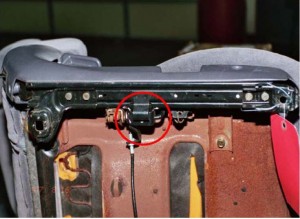Opponents of Chrysler and General Motors’ bid to play the get-out-of-liability-free card scored a partial victory Friday. GM agreed to amend the terms of its bankruptcy to assume liability for future death and injury claims. The deal was reportedly hammered out late Friday between the Treasury’s auto task force, GM and more than a dozen states attorneys general.
Category: litigation
Why the Problems Won’t Go Away When the Old Chrysler and GM Do
About 3,400 individuals will die or be injured in a General Motors or Chrysler vehicle due to an automotive defect in the companies’ first year post-bankruptcy, according to a new analysis conducted by Safety Research & Strategies
SRS has released its report, Public Safety at Risk: Bankruptcies Leave Legacy of Defects, Injuries and Deaths as part of its ongoing efforts to highlight the plight of the victims of the Chrysler and GM bankruptcies. Under the terms of each automaker’s transition from their old, debt-burdened incarnations to their liability-free future entities, hundreds of pending death and injury claims will be eliminated. But the latent – and in some cases, well-known, but never resolved – automotive defects will continue to manifest themselves in the 40 million GM and Chrysler vehicles built before Chapter 11, which remain in the U.S. fleet.
States Attorneys General File Objections to GM Bankruptcies
The states have begun to clamor for their rights in the dissolution of the old General Motors, filing a joint objection to the bankruptcy provision allowing the automaker to eliminate tort claims.
Following the path set by the Chrysler bankruptcy and sale to Fiat, GM has sought protection from liability claims for deaths and injuries that occur in vehicles manufactured before the bankruptcy. Eight states attorneys general, from Connecticut, Kentucky, Maryland, Minnesota, Missouri, Nebraska, North Dakota and Vermont filed an objection with the U.S. Bankruptcy Court in New York on Friday. Illinois, California, Kansas and Ohio have joined the objections.
Brass Ones
Government Motors – I mean – General Motors is doubling down on 363. That’s the magical section of the Chapter 11 bankruptcy code that allows filers to keep the good stuff and discard all the ick – one of the key pieces being liability for harm caused by defective products.
Senate Holds Hearing on Roof Strength; NHTSA Grilled on Pre-emption
WASHINGTON, D.C. – The chairman of the Senate Consumer Affairs, Insurance and Automotive sub-committee has urged the Secretary of Transportation to extend the July 1 deadline for a final roof crush rule and to drop the pre-emption clause from the regulation. Continue reading

Sebring Seat Back Case Reveals Defect that Mitsubishi Tried to Conceal; Attorney Vows to Pursue Fraud
MOBILE, ALABAMA – After settling a seat-track and airbag defects case against DaimlerChrysler and Mitsubishi, attorney Patrick M. Ardis says he will pursue a fraud investigation against the Japanese automaker.
Ardis, of Wolff Ardis, P.C. of Memphis, Tennessee, alleges that Mitsubishi deliberately concealed that it had changed the design of the seat tracks in 1995-2000 Chrysler Sebring and Dodge Avenger coupes, the 1995-1999 Mitsubishi Eclipse, and the 1995-1998 Eagle Talon vehicles to fix a flaw that prevented the front passenger seat from locking into place. Ardis and his co-counsel Richard Taylor discovered the alleged fraud on the eve of trial, when one of their expert witnesses, Don Phillips, stumbled onto evidence that the seat tracks in the 1998 and 1999 model years lacked the seat adjuster part, known as the trigger, that was part of the 1996 track assembly. Continue reading
Judge Orders NHTSA To Revisit Early Warning Records Rulemaking
Reprinted from The Safety Record, V3 Issue 3, May/June 2006
Washington, D.C. – A U.S. District Court judge has kicked the National Highway Traffic Safety Administration final rule on the confidentiality of records submitted under the Transportation Recall Enhancement, Accountability and Documentation (TREAD) Act back to the agency. On March 31, Judge Robert Leon found that NHTSA “pulled a switcheroo” when it published its Business Information Confidentiality rule regarding the confidentiality of defect-related information in the early warning database established under TREAD nearly three years ago, and did not allow adequate opportunity for public comment. Continue reading
Federal Government Increasingly Uses Pre-Emption to Bypass State Laws
Consumer and state government groups are becoming alarmed at a surge of regulations and bills designed to protect industry, while usurping stronger state regulations and consumers’ rights in state courts through pre-emption clauses and laws. Continue reading
States Rights Advocates Attack NHTSA Roof Crush Preemption Proposal
A provision in National Highway Traffic Safety Administration’s proposed roof crush standard that would preempt state tort law would transfer the societal costs of caring for rollover crash victims to the states, discourage manufacturers from improving vehicles’ crashworthiness and usurp Congressional authority, a diverse group of influential commenters has argued.
For the first time in 32 years, the NHTSA is proposing to strengthen vehicle roofs and extend the standard to cover vehicles with a Gross Vehicle Weight Rating of 10,000 pounds, as part of an alleged “comprehensive plan for reducing the risk of death and serious injury from rollover crashes.” The proposed regulation would increase the force that vehicles are required to withstand from 1.5 to 2.5 times their unloaded vehicle weight and replace the 22,240 Newton maximum force limit for passenger cars. It would also change the certifying test from the current plate movement limit of 5 inches with a new direct limit on headroom reduction. (See The Safety Record, V2, I4). Continue reading
Court Will Hear Public Citizen’s Motion To Unseal Volvo Documents
A Florida judge has granted the advocacy group Public Citizen a hearing next month to determine if the court should again make public “critically important auto safety documents” on roof strength that helped the plaintiffs win a $10.2 million verdict in Duncan v. Ford. Continue reading